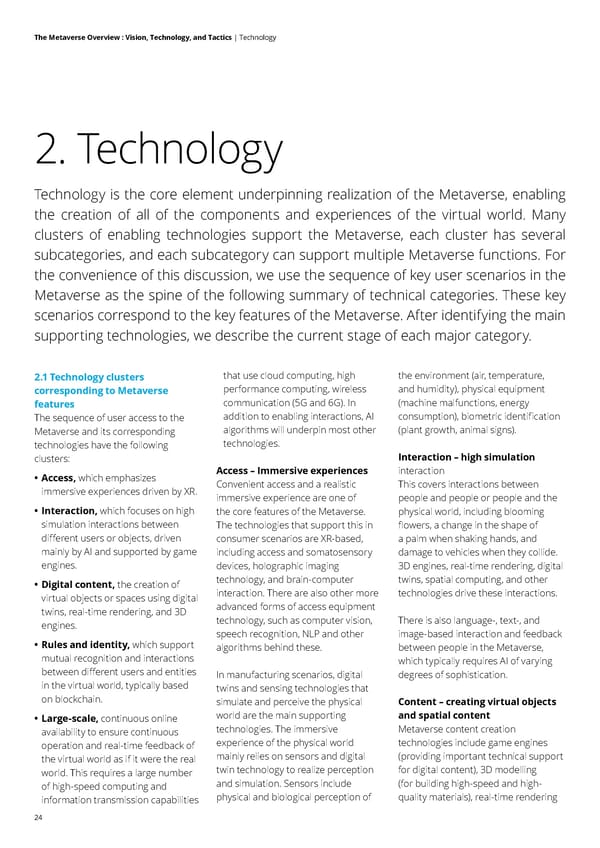24 The Metaverse Overview : Vision, Technology, and Tactics | Technology 2. Technology 2.1 Technology clusters corresponding to Metaverse features The sequence of user access to the Metaverse and its corresponding technologies have the following clusters: • Access, which emphasizes immersive experiences driven by XR. • Interaction, which focuses on high simulation interactions between different users or objects, driven mainly by AI and supported by game engines. • Digital content, the creation of virtual objects or spaces using digital twins, real-time rendering, and 3D engines. • Rules and identity, which support mutual recognition and interactions between different users and entities in the virtual world, typically based on blockchain. • Large-scale, continuous online availability to ensure continuous operation and real-time feedback of the virtual world as if it were the real world. This requires a large number of high-speed computing and information transmission capabilities that use cloud computing, high performance computing, wireless communication (5G and 6G). In addition to enabling interactions, AI algorithms will underpin most other technologies. Access – Immersive experiences Convenient access and a realistic immersive experience are one of the core features of the Metaverse. The technologies that support this in consumer scenarios are XR-based, including access and somatosensory devices, holographic imaging technology, and brain-computer interaction. There are also other more advanced forms of access equipment technology, such as computer vision, speech recognition, NLP and other algorithms behind these. In manufacturing scenarios, digital twins and sensing technologies that simulate and perceive the physical world are the main supporting technologies. The immersive experience of the physical world mainly relies on sensors and digital twin technology to realize perception and simulation. Sensors include physical and biological perception of the environment (air, temperature, and humidity), physical equipment (machine malfunctions, energy consumption), biometric identification (plant growth, animal signs). Interaction – high simulation interaction This covers interactions between people and people or people and the physical world, including blooming flowers, a change in the shape of a palm when shaking hands, and damage to vehicles when they collide. 3D engines, real-time rendering, digital twins, spatial computing, and other technologies drive these interactions. There is also language-, text-, and image-based interaction and feedback between people in the Metaverse, which typically requires AI of varying degrees of sophistication. Content – creating virtual objects and spatial content Metaverse content creation technologies include game engines (providing important technical support for digital content), 3D modelling (for building high-speed and high- quality materials), real-time rendering Technology is the core element underpinning realization of the Metaverse, enabling the creation of all of the components and experiences of the virtual world. Many clusters of enabling technologies support the Metaverse, each cluster has several subcategories, and each subcategory can support multiple Metaverse functions. For the convenience of this discussion, we use the sequence of key user scenarios in the Metaverse as the spine of the following summary of technical categories. These key scenarios correspond to the key features of the Metaverse. After identifying the main supporting technologies, we describe the current stage of each major category.
 Deloitte The Metaverse Overview Page 23 Page 25
Deloitte The Metaverse Overview Page 23 Page 25